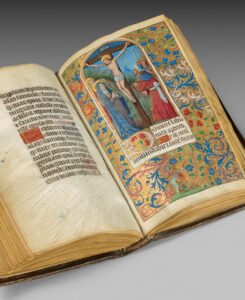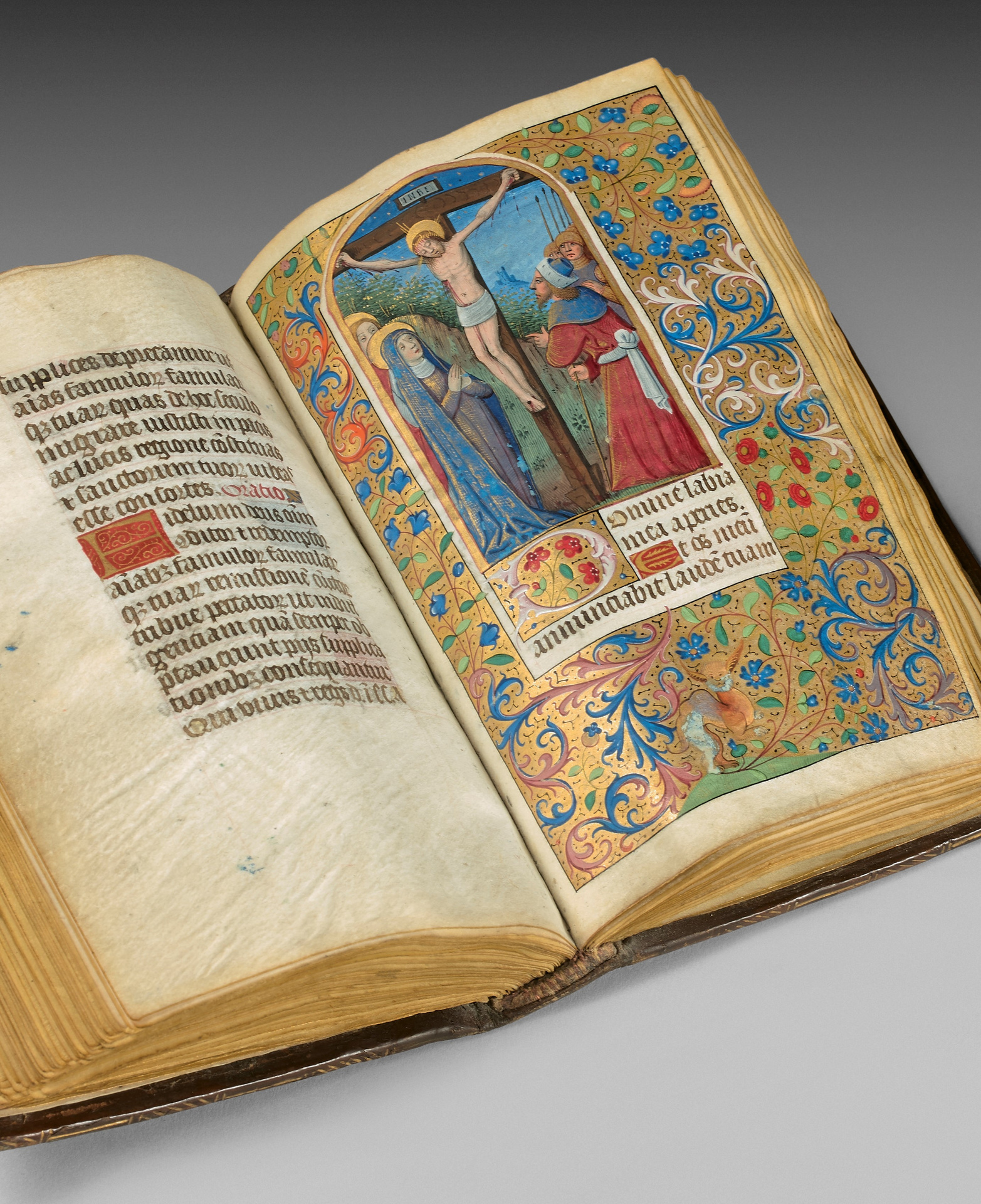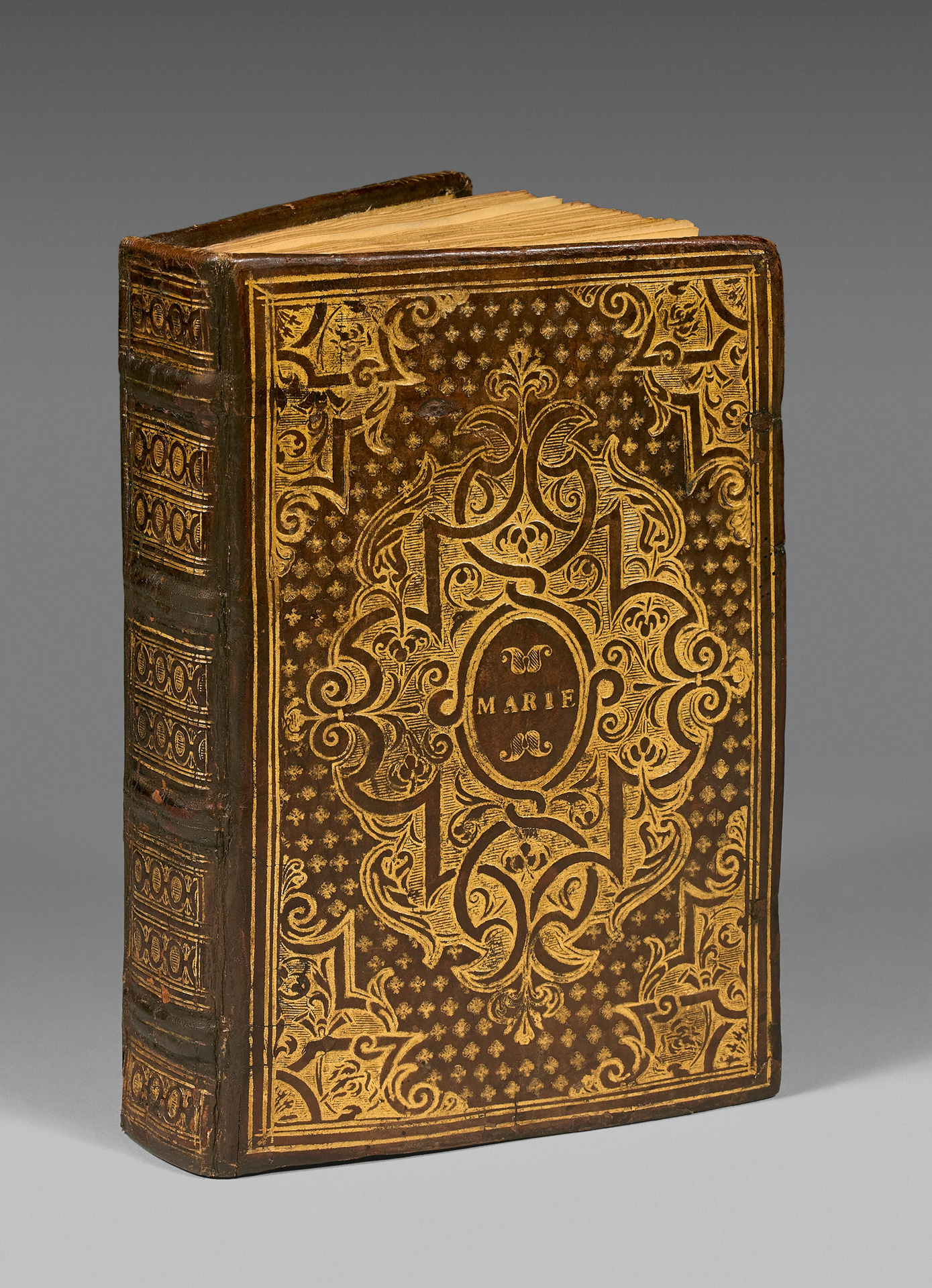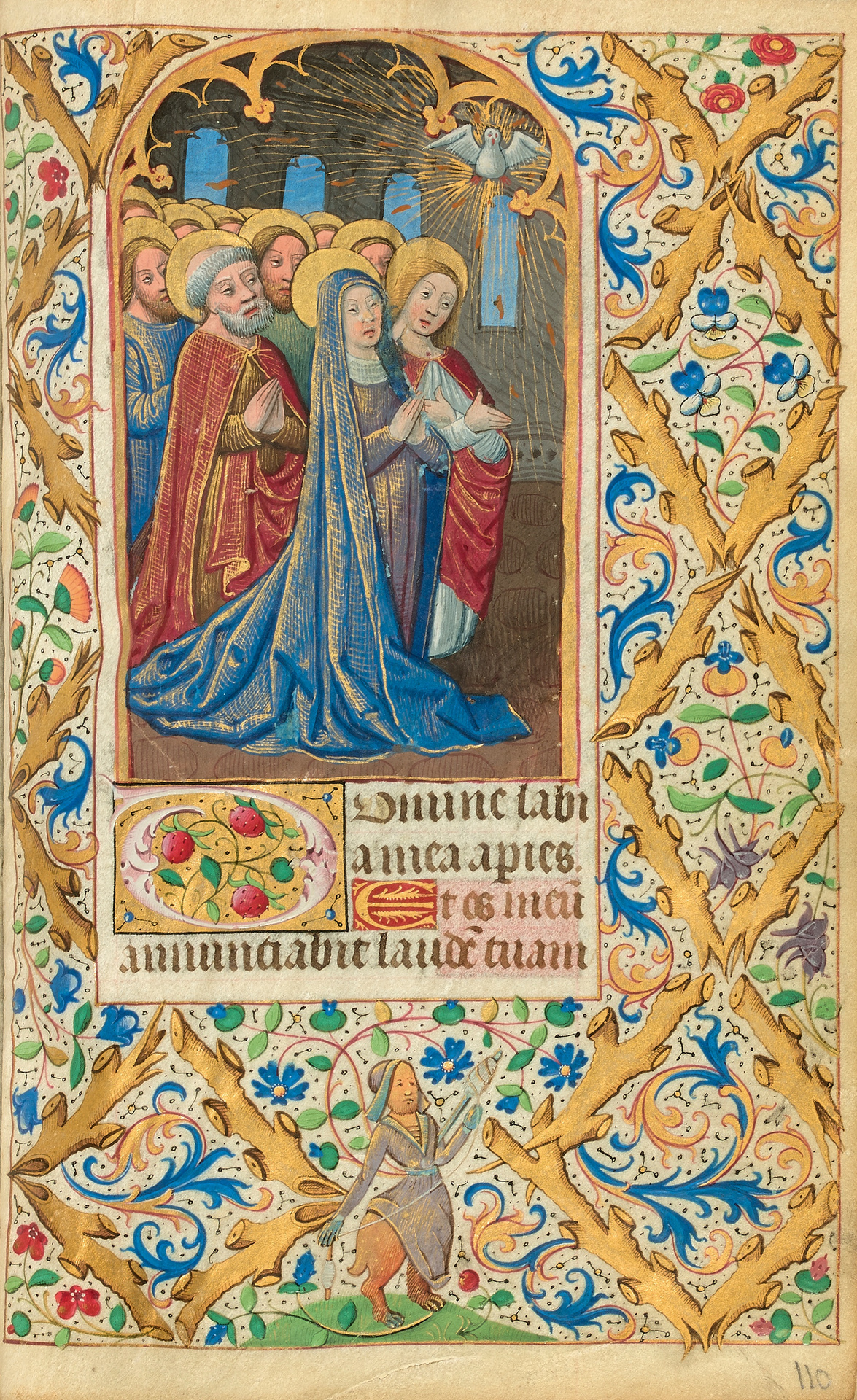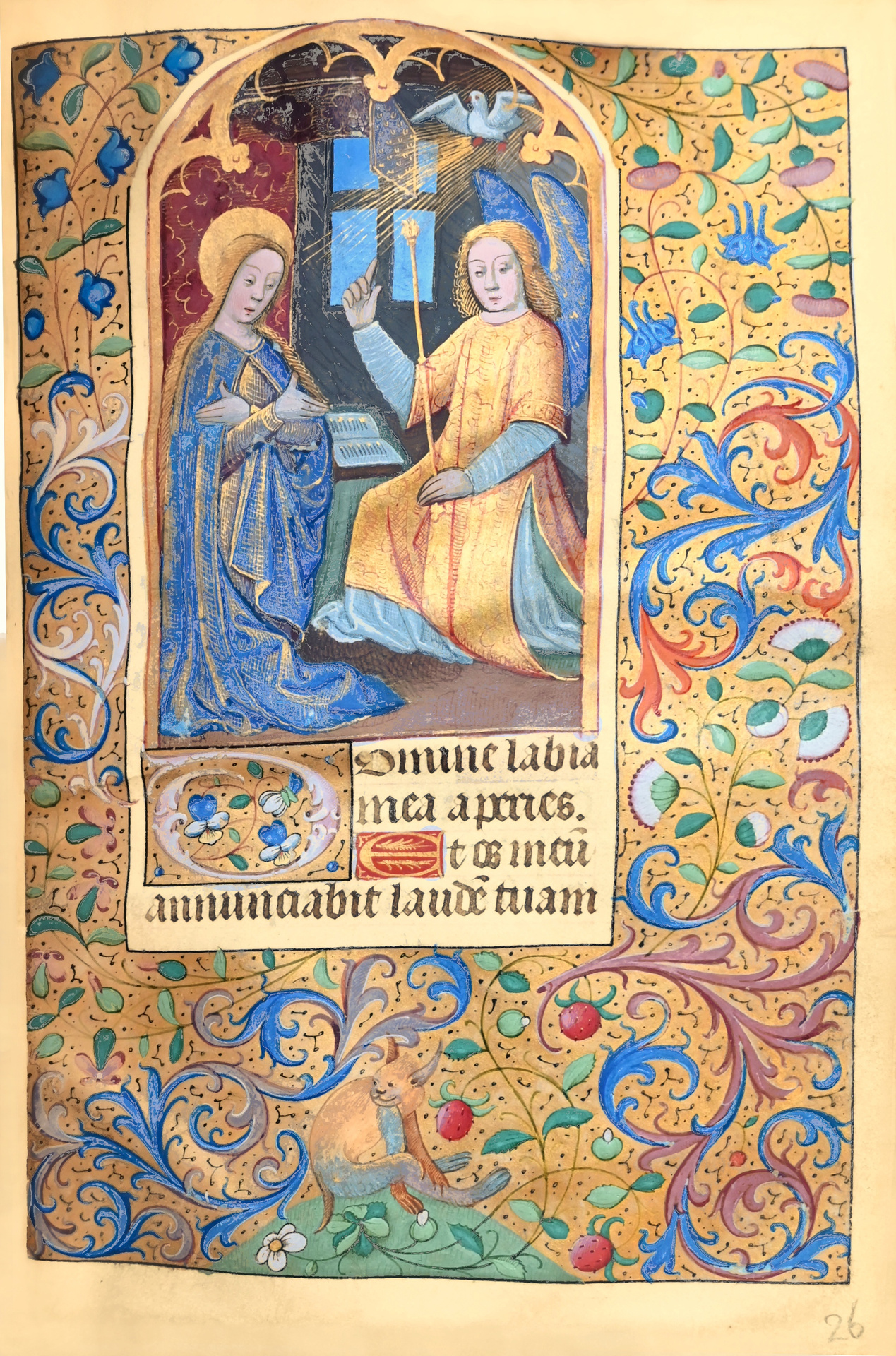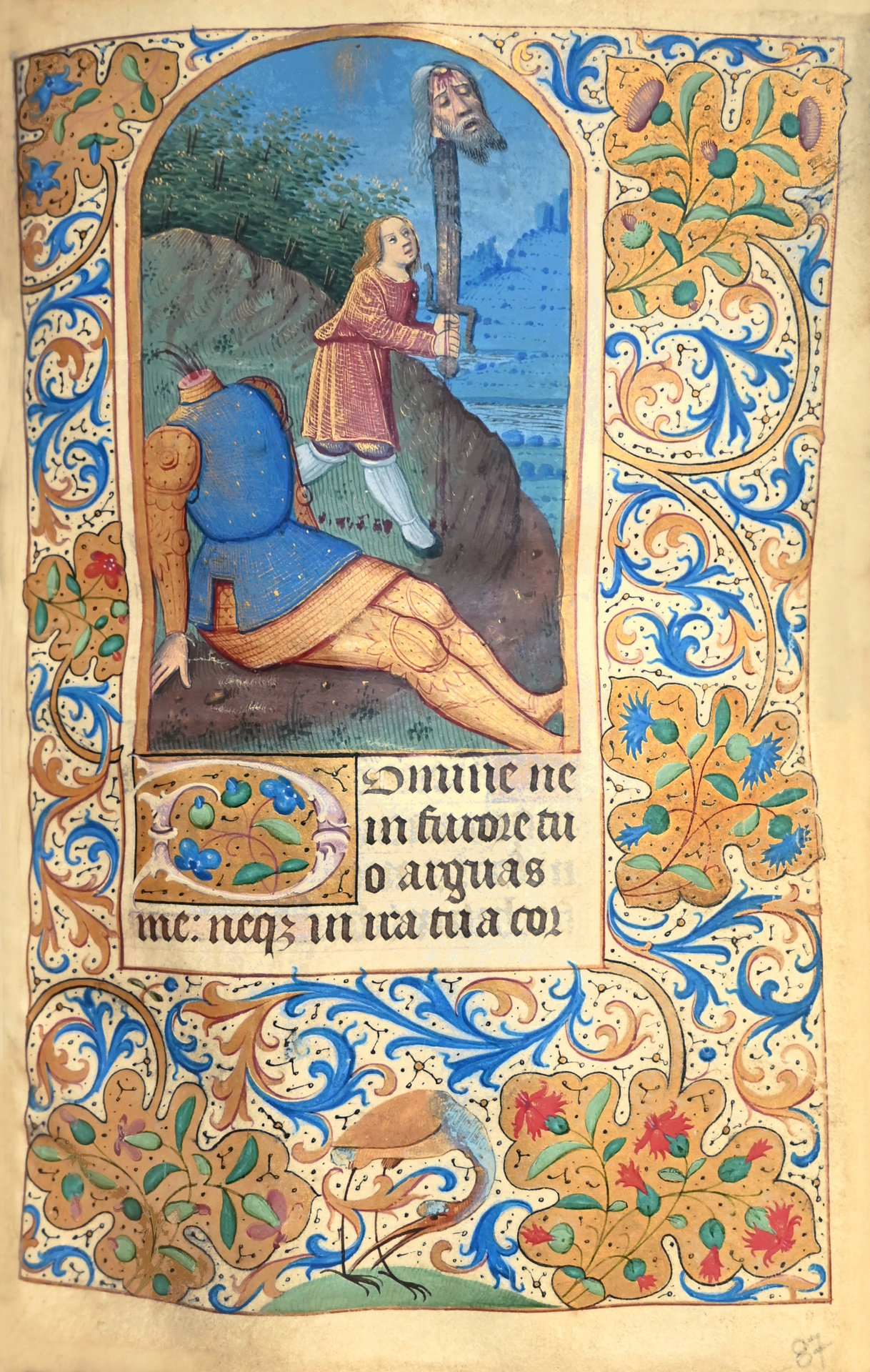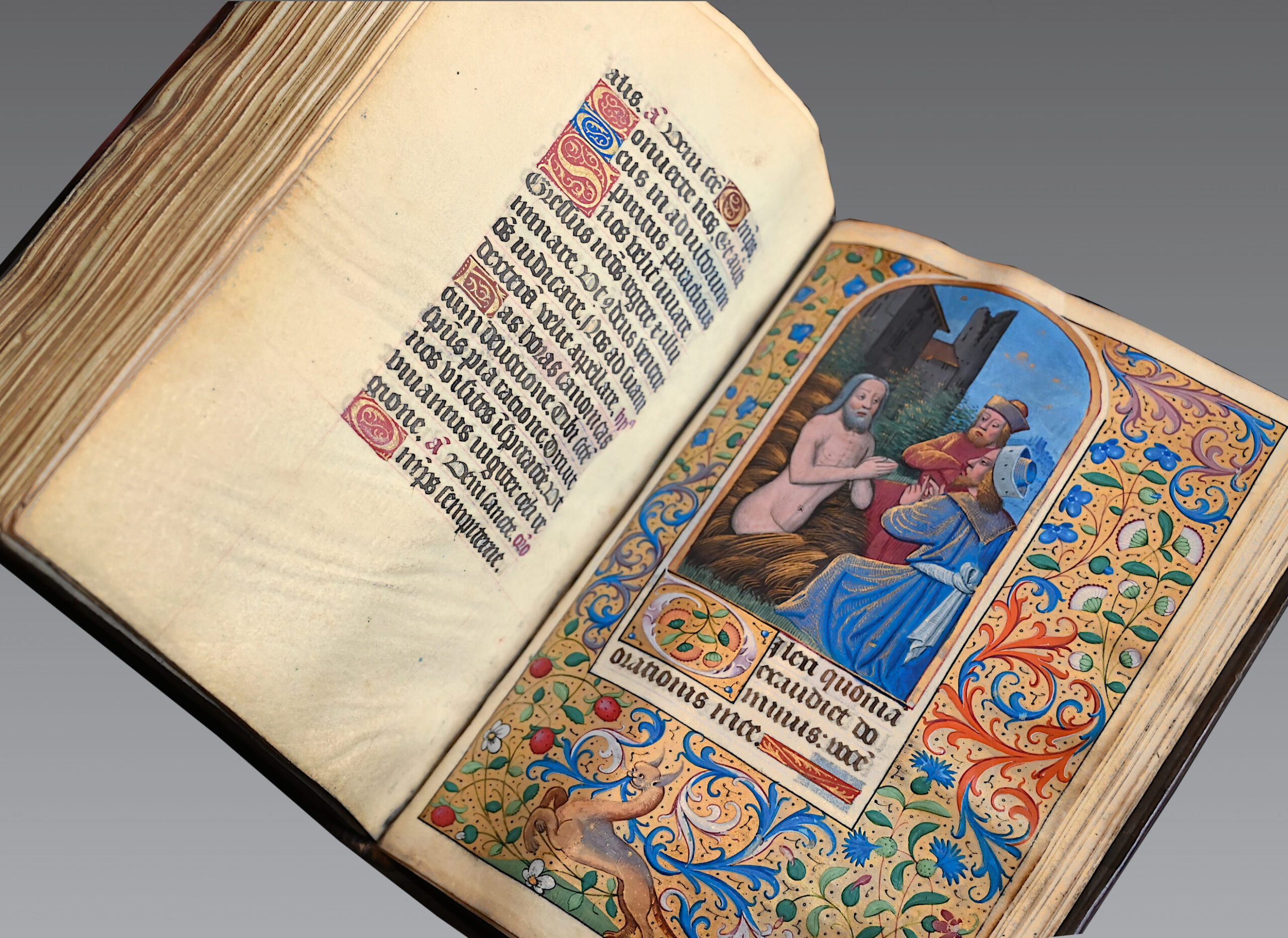Paris, circa 1485.
Small 8vo [155 x 103 mm] of 150 ll. on vellum skin, first and last leaves blank. Ruled copy.
Gothic handwriting in brown ink, the calendar in French in blue, red and gold ink.
Calendar justification: 80 x 50 mm, 17 long lines,
Latin text justification: 81 x 50 mm, 16 long lines, textura script, ll. 25v and 86v blank.
Brown calf, covers entirely decorated with gilt decor, large diamond pattern in the centre with supra-libris, ribbed spine, gilt edges, remains of ties. Binding from Lyons, mid 16th century.
A shimmering illuminated manuscript illustrated with 6 full-page paintings of remarkable quality of execution and shimmering colours, testifying to the art of French illuminators under the reign of Charles VIII.
The text:
Ll. 1-12v Calendar in French with a saint for each day of the year in gold, blue and red ink derived from Perdrizet 1933 (presence of Saint Arragonde on 30 January, Saint Amant on 6 February, Saint Vaast on 8 August).
Ll. 13-18v Pericopes of the 4 Gospels.
Ll. 18v-25 Obsecro te and O Intemerata written in the masculine.
Ll. 26-86 Hours of the Virgin for use in Paris.
Ll. 87-105v Psalms of Penance followed by s. Denis, s. Gervais, s. Prothais and s. Germain.
Ll. 106-112v Hours of the Cross and Hours of the Holy Spirit.
Ll. 113-148v The Office of the Dead for the use of Paris.
Ornamentation: The decoration includes 6 large full-page miniatures of beautiful factory.
L. 13 Saint John the Evangelist on the island of Patmos with the eagle and a large rock behind him.
L. 26 Annunciation: the Virgin has her hands crossed on her chest, her book is placed behind her, the angel greets her.
L. 87 David defeating Goliath in a beautiful landscape of blue and green hills.
L. 106 Crucifixion: the Virgin and Saint John are praying on the left, the centurion and his soldiers are on the right. The centurion is wearing a knotted belt. The sky is filled with small gold dots.
L. 110 Pentecost: the scene is built on a diagonal. The Virgin prays in front followed by the apostles. St John is next to her and St Peter behind her.
L. 113 Job on the dunghill with a friend wearing a knotted belt.
Superb framings on four sides of the miniatures with scaled trunks and a hybrid on l. 13, a heron on l. 87, a hybrid woman on a gold background on l. 110, a hybrid on ll. 26 and 113 on a compartmented parchment background.
Side borders on l. 18v, 22v, at the head of the Hours on ll. 48v, 60, 65, 68, 71v, 75, 81v.
Initials on 1 and 2 lines with red and blue background letter in gold, initials on 3 lines in Paris with gold background letter in white and pink scroll and red background letter in white and blue scroll.
Very beautiful manuscript in perfect condition illuminated by an artist with several names.
J. Plummer and J. Lauga name him le Maître du Morgan 26 and set the beginning of his career in Langres (J. Lauga, Les manuscrits liturgiques dans le diocèse de Langres à la fin du Moyen Age. Les commanditaires et leurs artistes, 2007, Université de Paris IV, direction F. Joubert, vol. 1, p. 273-284, vol. 2, notice 58, p. 577-611, notice 56, p. 541-560).
J. Plummer and Fr. Avril attribute to him the Jeu des échecs moralisés (Paris BnF., Ms. Fr. 2000).
Fr. Avril gives him the name of Maître du Romuléon of the Museum of Cluny according to the fragments (Cl. 1804 and Cl 1819) of Limoges, Niort Rés. G.2.F.
The artist was inspired by Germanic models. Thus the comparison of Jesus before Pilates in Morgan 26 is an exact replica of an engraving by Israel van Meckenem reproduced in Bartsch illustrated 493 (fig. 354-355) as recognized by J. Lauga.
The moralized chess bears the arms of Nicolas d’Anjou, grandson of King René, son of Jean de Galabre, who died in 1473, but the style is more reminiscent of the 1480s, as suggested by N. Reynaud in 1993 (Les manuscules d’Anjou). Reynaud in 1993 (Les manuscrits à peintures en France 1440-1520, cat. 213). The author proposes that the manuscript left unfinished could have been completed for René II of Lorraine. M. Herman proposes, following Fr. Avril, that the manuscript was offered by Yolande D’Aragon to her son René II of Lorraine (“Enluminure et commande de manuscrit enluminés“, Langres à la Renaissance, cat. expo. 19 May to 7 Oct. 2018 Musée d’Art et d’histoire de Langres, Ars-en-Moselle, Langres 2018, p. 336-340 notice 83).
N. Reynaud attributes to him the Vienna codex 2538 La Guerre des Juifs which seems to have been painted for Louis de Laval or François de Laval. The manuscript was copied by Pierre Rouche of Langres who also worked in Paris.
I. Delaunay proposes to identify him with Pierre Garnier, a painter in the service of King René from 1476 to 1480 who came to Paris around 1485 (Echanges artistiques entre livres d’heures manuscrits et imprimés produits à Paris vers 1480-1500, Paris université de Paris, ss. La direction de f. Joubert, Thése 2000, t. I, p. 186, t. II, p. 57-60). In addition, he was inspired by an artist active at the court of Lorraine: Georges Trubert. He uses his mid-body framing in several of his manuscripts.
The same rock behind St John is found in the Hours for the use of Langres Pierpont Morgan Library M. 26 and the miniature of the same subject in Chaumont 34. Small golden dots to light up the sky are common to the New York Pieta. The pinkish faces are very beautiful.
The artist illuminates other Parisian manuscripts (Paris, BnF. Ms. Latin 13295 and 1423).
The manuscript was bound in the mid-16th century in an elegantly decorated binding in the Lyons’ style.
Provenance: from the library of Marie/de/Lisle with supra libris covering the two covers.
